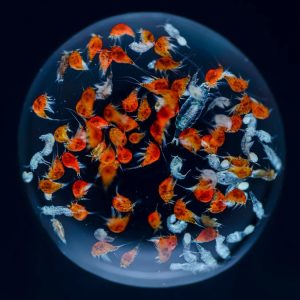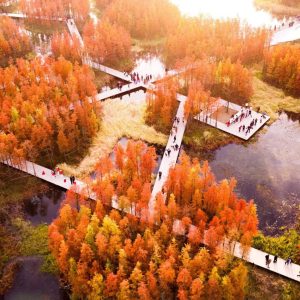Link About It: This Week’s Picks
Controlling lightning with lasers, transforming dumps into parks, mapping subterranean passageways and more

The First 3D-Printed Two-Story Home in the US
 New York design firm Hannah, Germany-based company Peri 3D Construction, and Texas engineering and construction firm Cive have partnered to create the first 3D-printed two-story home in the US—currently being built in Houston. The 4,000-square-foot, three-bedroom property will serve as a case study on how to best streamline 3D-printed construction, test the capabilities of the machine and learn how materials hold up under different conditions. The feat makes strides in the nearly decade-long survey of using printing technology to build houses that, in comparison to concrete, are cheaper to make and more resilient in the face of natural disasters. “The printer doesn’t care if you print the same chair 100 times or you print 100 different chairs,” says Leslie Lok, a co-founder of Hannah. “This opens up the possibility of how we can actually offer customized design for the users, whether it’s a single-family house or whether it’s a multifamily building or apartment.” Learn more about the project and the benefits of 3D printing at NPR.
New York design firm Hannah, Germany-based company Peri 3D Construction, and Texas engineering and construction firm Cive have partnered to create the first 3D-printed two-story home in the US—currently being built in Houston. The 4,000-square-foot, three-bedroom property will serve as a case study on how to best streamline 3D-printed construction, test the capabilities of the machine and learn how materials hold up under different conditions. The feat makes strides in the nearly decade-long survey of using printing technology to build houses that, in comparison to concrete, are cheaper to make and more resilient in the face of natural disasters. “The printer doesn’t care if you print the same chair 100 times or you print 100 different chairs,” says Leslie Lok, a co-founder of Hannah. “This opens up the possibility of how we can actually offer customized design for the users, whether it’s a single-family house or whether it’s a multifamily building or apartment.” Learn more about the project and the benefits of 3D printing at NPR.
Image courtesy of Hannah
Photographer Angel Fitor Captures Life Inside a Drop of Seawater
 A single drop of seawater can teem with living creatures. Though this world is invisible to the naked eye, Spanish wildlife photographer Angel Fitor devised a way to capture these infinitesimal ecosystems, from the mating of copepods (one of the most abundant animals on the planet, which range from 0.2 to 1.7 millimeters long) to a sea worm protecting an egg. The project took three years to perfect. The process behind it begins with gathering water samples from the Mediterranean Sea and immediately photographing them so as not to lose the vibrant colors of the copepods who turn a dull brown when they die. Under LED lighting and strong air conditioning (which prevents the water from evaporating), Fitor uses binoculars to pipette a single droplet, which takes hours as some samples do not contain any creatures. The result is awe-inspiring and vivid. Read more about his work and view his photography at Smithsonian Magazine.
A single drop of seawater can teem with living creatures. Though this world is invisible to the naked eye, Spanish wildlife photographer Angel Fitor devised a way to capture these infinitesimal ecosystems, from the mating of copepods (one of the most abundant animals on the planet, which range from 0.2 to 1.7 millimeters long) to a sea worm protecting an egg. The project took three years to perfect. The process behind it begins with gathering water samples from the Mediterranean Sea and immediately photographing them so as not to lose the vibrant colors of the copepods who turn a dull brown when they die. Under LED lighting and strong air conditioning (which prevents the water from evaporating), Fitor uses binoculars to pipette a single droplet, which takes hours as some samples do not contain any creatures. The result is awe-inspiring and vivid. Read more about his work and view his photography at Smithsonian Magazine.
Image courtesy of Angel Fitor
Using Lasers to Direct Lightning Strikes
 For the first time ever, scientists have redirected the path of lightning bolts with lasers. During a demonstration atop Switzerland’s Säntis mountain, researchers fired rapid laser pulses at thunderclouds for more than six hours and observed lasers diverting four different lightning strikes. One was filmed in clear enough conditions to demonstrate how the bolt steered the path of the laser for around 50 meters. A laser is able to influence lightning because it ionizes air molecules when it is fired into the sky. This causes them to move and heat up rapidly, forming a chain (for only a millisecond) that is more electrically conductive to give the lightning something to easily flow along. Learn more about the strategy which could be key to protecting airports, tall buildings and other locations at The Guardian.
For the first time ever, scientists have redirected the path of lightning bolts with lasers. During a demonstration atop Switzerland’s Säntis mountain, researchers fired rapid laser pulses at thunderclouds for more than six hours and observed lasers diverting four different lightning strikes. One was filmed in clear enough conditions to demonstrate how the bolt steered the path of the laser for around 50 meters. A laser is able to influence lightning because it ionizes air molecules when it is fired into the sky. This causes them to move and heat up rapidly, forming a chain (for only a millisecond) that is more electrically conductive to give the lightning something to easily flow along. Learn more about the strategy which could be key to protecting airports, tall buildings and other locations at The Guardian.
Image courtesy of James “Bo” Insogna
New York Bans Forever Chemicals From Clothing
 A new bill has passed in New York that bans the selling and distribution of apparel that contains toxic chemicals across the state. The move, which is slated to go into effect by the end of the year, follows a similar mandate passed in California. The noted chemicals—perfluoroalkyl and polyfluoroalkyl (aka PFAs or forever chemicals)—are notoriously difficult to recycle, contribute to environmental damage and are believed to cause cancer and other illnesses. Eliminating them is a step forward in protecting the health of the planet and people. Learn more about the move at The Hill.
A new bill has passed in New York that bans the selling and distribution of apparel that contains toxic chemicals across the state. The move, which is slated to go into effect by the end of the year, follows a similar mandate passed in California. The noted chemicals—perfluoroalkyl and polyfluoroalkyl (aka PFAs or forever chemicals)—are notoriously difficult to recycle, contribute to environmental damage and are believed to cause cancer and other illnesses. Eliminating them is a step forward in protecting the health of the planet and people. Learn more about the move at The Hill.
Image courtesy of Unsplash/Marcus Loke
Laser-Based Technology is Making Archeology More Accessible
 Souterrains are subterranean passageways in the Scottish Highlands from the Iron Age. Nobody, however, has seen one fully intact or understands what function they served. While surveying them has been a lengthy and difficult process, archeologists are now using laser scanners (the Leica BLK360, in particular) to make them more accessible. This new equipment can scan the walls of souterrains at 10,000 times a second, which is undeniably quicker than drawing or photographing each surface. Scientists convert that data with the help of Blender, Trimble RealWorks and NUBIGON to create 3D models that can be accessed at places like museums or heritage sites. It also allows researchers to further examine the caves from different angles, take additional measurements and give virtual tours of the passages. Read more about this digitized archeology at Wired.
Souterrains are subterranean passageways in the Scottish Highlands from the Iron Age. Nobody, however, has seen one fully intact or understands what function they served. While surveying them has been a lengthy and difficult process, archeologists are now using laser scanners (the Leica BLK360, in particular) to make them more accessible. This new equipment can scan the walls of souterrains at 10,000 times a second, which is undeniably quicker than drawing or photographing each surface. Scientists convert that data with the help of Blender, Trimble RealWorks and NUBIGON to create 3D models that can be accessed at places like museums or heritage sites. It also allows researchers to further examine the caves from different angles, take additional measurements and give virtual tours of the passages. Read more about this digitized archeology at Wired.
Image courtesy of AOC Archeology
Sortis Holdings Purchases Ace Hotel Chain for $85 Million
 Portland, Oregon-based Sortis Holdings (a group that owns various hospitality brands) is set to purchase the Ace Group—which owns and runs the Ace brand, Maison de la Luz, Sister City and Atelier Ace. The all-cash transaction has been led by Kelly Sawdon, who joined Sortis in 2021 and previously held a position as partner at the Ace Hotel Group. She had “been a key player in the [Ace] brand since shortly after its creation by three friends (Doug Herrick, Alex Calderwood and Wade Weigel) in 1999 in Seattle.” The acquisition is part of a larger move by Sortis to own more “lifestyle”-leaning businesses—or what the company is calling “spirited cultural hubs.” These are places that “embrace locals and out-of-towners and may be located at resorts and luxury camping properties as well as in cities.” Find out more about the deal, and whether the price is right, at Skift.
Portland, Oregon-based Sortis Holdings (a group that owns various hospitality brands) is set to purchase the Ace Group—which owns and runs the Ace brand, Maison de la Luz, Sister City and Atelier Ace. The all-cash transaction has been led by Kelly Sawdon, who joined Sortis in 2021 and previously held a position as partner at the Ace Hotel Group. She had “been a key player in the [Ace] brand since shortly after its creation by three friends (Doug Herrick, Alex Calderwood and Wade Weigel) in 1999 in Seattle.” The acquisition is part of a larger move by Sortis to own more “lifestyle”-leaning businesses—or what the company is calling “spirited cultural hubs.” These are places that “embrace locals and out-of-towners and may be located at resorts and luxury camping properties as well as in cities.” Find out more about the deal, and whether the price is right, at Skift.
Image of Ace Hotel Brooklyn
Creating a Smart Voice Assistant by Combining Siri and GPT-3
 Web developer and creative technologist Mate Marschalko created an improved and intuitive smart voice-assistant by combining AI-system GPT-3 with Siri. Without having to write any code, Marschalko verbally coached GPT-3 to understand casual English, interpreting personal questions and recognizing common requests around the home. These responses were nested under “HomeKit” which he set up using a Siri shortcut. As he notes in his blog post, he tested it by telling the AI, “Just noticed that I’m recording this video in the dark in the office. Can you do something about that?” The smart assistant then turned on the lights. It even figures things out for itself. For example, Marschalko told the AI he wanted a temperature that would help him sleep and the smart assistant changed the thermostat to 19 degrees Celsius. Learn more about the impressive project at 9to5Mac.
Web developer and creative technologist Mate Marschalko created an improved and intuitive smart voice-assistant by combining AI-system GPT-3 with Siri. Without having to write any code, Marschalko verbally coached GPT-3 to understand casual English, interpreting personal questions and recognizing common requests around the home. These responses were nested under “HomeKit” which he set up using a Siri shortcut. As he notes in his blog post, he tested it by telling the AI, “Just noticed that I’m recording this video in the dark in the office. Can you do something about that?” The smart assistant then turned on the lights. It even figures things out for itself. For example, Marschalko told the AI he wanted a temperature that would help him sleep and the smart assistant changed the thermostat to 19 degrees Celsius. Learn more about the impressive project at 9to5Mac.
Image courtesy of Mate Marschalko
England Bans Single-Use Plastic Cutlery and Plates
 Set to take effect in October this year, single-use plastic cutlery and plates, as well as polystyrene trays have been banned by the British Government. The ban is directed toward cafes and restaurants, but will apply to supermarkets and stores through a separate measure that will also see manufacturers be responsible for disposal costs within the next two years. Scotland and Wales already have similar restrictions in effect. It’s one of hopefully many new regulations to reduce pollution in England (where “government figures suggest that 1.1 billion single-use plates and more than four billion pieces of plastic cutlery are used”) and beyond. Read more at BBC.
Set to take effect in October this year, single-use plastic cutlery and plates, as well as polystyrene trays have been banned by the British Government. The ban is directed toward cafes and restaurants, but will apply to supermarkets and stores through a separate measure that will also see manufacturers be responsible for disposal costs within the next two years. Scotland and Wales already have similar restrictions in effect. It’s one of hopefully many new regulations to reduce pollution in England (where “government figures suggest that 1.1 billion single-use plates and more than four billion pieces of plastic cutlery are used”) and beyond. Read more at BBC.
Image courtesy of Unsplash/Padraig Treanor
Transforming a Dumping Ground Into a Floating Forest in China
 Fish Tail Park is a new 126-acre floating forest in Nanchang, China that helps regulate floods, restore wildlife habitation and create a recreational area for the city. Transforming what was once a dumping ground, Beijing-based landscape architecture firm Turenscape built numerous islets, created by recycling coal ash found on location and mixing it with dirt. The islets house recreational areas like beaches, fountains and playgrounds and are connected by a series of walkways and bridges, surrounded by a new lake that will help capture up to one million cubic meters of stormwater. Native trees and wetland plants encircle the park to protect the shoreline and aid in biodiversity. Equipped to accommodate 20-year floods, the project presents a proof of concept for urban development that benefits nature and people. Learn more at Archinect.
Fish Tail Park is a new 126-acre floating forest in Nanchang, China that helps regulate floods, restore wildlife habitation and create a recreational area for the city. Transforming what was once a dumping ground, Beijing-based landscape architecture firm Turenscape built numerous islets, created by recycling coal ash found on location and mixing it with dirt. The islets house recreational areas like beaches, fountains and playgrounds and are connected by a series of walkways and bridges, surrounded by a new lake that will help capture up to one million cubic meters of stormwater. Native trees and wetland plants encircle the park to protect the shoreline and aid in biodiversity. Equipped to accommodate 20-year floods, the project presents a proof of concept for urban development that benefits nature and people. Learn more at Archinect.
Image courtesy of Turenscape
Link About It is our filtered look at the web, shared daily in Link and on social media, and rounded up every Saturday morning. Hero image courtesy of Ace Hotel Brooklyn












